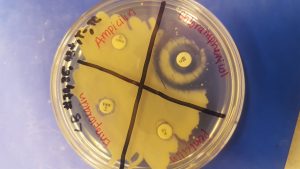The National Toxicology Program (NTP) just released an updated fact sheet on mold in the built environment. Very handy introduction to the subject, including some information on current research on the topic. Thanks to James Scott for bringing this to our attention.
Last September, I watched Greg Wilson’s three-minute pitch for Software Carpentry, and I was SOLD! Do I want to get more done at the computer in less time? Absolutely! The only difficulty was waiting until this week for it to happen. Finally, this past Monday and Tuesday (May 13-14,) Software Carpentry arrived at UC Davis. …
The Alfred P. Sloan Foundation has created a new funding opportunity in its Microbiology of the Built Environment (MoBE) program. The Foundation seeks to further the development of talented early stage Ph.D. scientists and engineers by establishing the Microbiology of the Built Environment (MoBE) Postdoctoral Fellowship program. The program will provide support for postdoctoral researchers …
In their just published paper in Environmental Science & Technology, “Tetracycline Resistance and Class 1 Integron Genes Associated with Indoor and Outdoor Aerosols,” Alison L. Ling, Norman R. Pace, Mark T. Hernandez, and Timothy M. LaPara have found that genes escape the indoor environment and can be found 2 km away. The abstract can be …
At microBEnet one of our goals has been to experiment with various forms of social media and to see if / how it can be useful in general to the field of “microbiology of the Built Environment.” For those interested in such things, as well as for anyone interesting in the interface between social media …
Two new papers out from the microBEnet Undergraduate Research: Built Environment Reference Genomes project: Coil DA, Doctor JI, Lang JM, Darling AE, Eisen JA. 2013. Draft Genome Sequence of Kocuria sp. Strain UCD-OTCP (Phylum Actinobacteria). Genome Announc. 1(3):e00172-13. doi:10.1128/genomeA.00172-13. Diep AL, Lang JM, Darling AE, Eisen JA, Coil DA. 2013. Draft genome sequence of Dietzia sp. strain UCD-THP (phylum …
After some off-line dialogue related to my “Should you lick your baby’s dropped pacifier?” blog post, I have decided to post a separate comment regarding the hygiene hypothesis, mentioned in the introduction, and the plasticizer hypothesis, emphasized by some off-line correspondents. What is clear is that in the modern, human-occupied indoor environment, there are microbes …
A story on the May 6th NPR program, Morning Edition, “Parents’ Saliva On Pacifiers Could Ward Off Baby’s Allergies” features a focus on the human microbiome, partental behavior and babies’ allergies. “That word “microbiome” – describing the collection of bacteria that live in and on our bodies – keeps popping up. This time, researchers say …
We have a guest post from Keith Seifert today. Keith is PI of the “Indoor Mycota Barcode of Life” (IM-BOL) project. See his post below: Walking in the footsteps of van Leeuwenhoek (part 1) “And therewithall, whenever I found out anything remarkable, I have thought it my duty to put down my discovery on paper, …
Members of The American Industrial Hygiene Association (AIHA) do a lot of investigations of “problem buildings.” Mold has been a hot topic for more than a decade due to numerous lawsuits brought by occupants, tenants, and others against building owners. Large settlements have occurred, and famous plaintiffs and lawyers (Erin Brokavich) have been involved. Whole …

